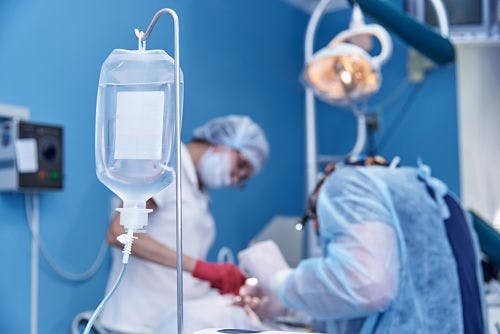What is VGS?
Vertical Sleeve Gastrectomy (VSG) surgery is a bariatric procedure in which 75% to 80% of your stomach is removed so that it can only hold three to four ounces of food. Limiting the amount of food you can consume in a single sitting helps you lose weight. The greatly reduced stomach, shaped like a banana, causes you to feel full much faster. In addition, VSG weight loss surgery removes the portion of the stomach responsible for producing the hunger hormone ghrelin. This one-two punch of reduced food consumption means you will consume significantly fewer calories, leading to drastic long-term weight loss.
When Do You Need a Vertical Sleeve Gastrectomy?
Doctors typically recommend the VSG procedure when you have tried repeatedly to lose weight through diet and exercise. It's an option for extreme or morbid obesity, especially when underlying health conditions are present. Vertical sleeve gastrectomy is not a quick fix for weight loss but rather a tool to help you lose excess weight.
You are a good candidate for a vertical gastric sleeve if your body mass index (BMI) is 40 or higher and you are at least 100 pounds overweight. Bariatric surgeons may also recommend VSG weight loss surgery if your BMI is 35 to 39.9 and you have one or more of the following comorbid conditions affecting your health:
- Cardiovascular disease
- High cholesterol
- Hypertension
- Type II diabetes
- Obstructive sleep apnea
- Stroke
- Infertility
Some obese patients with a BMI of 30 to 34.9 may qualify for this gastric sleeve surgery if they have several serious comorbid conditions seriously affecting their quality of life.

For super obese patients who have an extremely BMI and are too heavy to have other bariatric procedures safely, VSG weight loss surgery is sometimes recommended as a first step to lose a significant amount of weight and then followed by a second procedure to add a malabsorptive component to reduce excess weight even further.
VSG Procedure - How It's Performed
Few bariatric surgeons perform VSG as an open procedure with large incisions these days. Typically, sleeve gastrectomy is a laparoscopic bariatric surgery that uses four to five small incisions in the upper abdomen no bigger than the finger's width to insert a tiny camera and the tools needed to reduce the size of your stomach. In a single-incision vertical sleeve gastrectomy (SILS), the surgeon makes only one incision through the belly button to insert the camera and surgical tools. Patients receive general anesthesia before the start of sleeve gastrectomy surgery.
Once the incisions for laparoscopic vertical sleeve gastrectomy are made, and the camera and instruments are inserted, the surgeon will inspect the stomach and divide the blood vessels to the stomach's lateral side. Carbon dioxide (CO2) is pumped into your stomach to give the surgeon room to work. The surgeon will insert a Bougie tube through your mouth to determine the size of your reduced stomach. A stapler is used to divide the stomach into two parts, starting from the valve leading to the small intestine and running to the top of the stomach. The continuous firing of the stapler creates the new, banana-shaped stomach with approximately 20-25% of its original volume. The surgeon then oversews the staple line to prevent staple line leaks and ensure the durability of the new, smaller stomach.
The larger, curved part of the stomach is decompressed and removed through one of the incisions. Sphincter muscles that allow food to enter and leave the stomach remain intact. Once the resectioning has finished, the surgeon removes the camera and instruments and closes the incisions with tiny sutures or tape. VSG surgery typically takes 60 to 90 minutes. You'll awaken in a recovery room where the medical staff will monitor you for complications.
What Can You Expect After the VSG Procedure?
Because VSG surgery is minimally invasive, you can expect less scarring, faster healing, reduced risk of complications and a quicker return to normal activities. Most patients remain in the hospital one to two nights following surgery.
Recovery in the Weeks Following VSG Surgery
The medical staff will encourage you to walk as soon as three to four hours after the surgery. Generally, pain is managed easily following the procedure, although you will have access to pain medication if needed. You will begin your new diet while still in the hospital. Following sleeve gastrectomy, you will only consume clear, sugar-free liquids for the first seven days and then transition to a full liquid diet. Most patients do not feel hungry in the first few weeks after VSG due to the smaller stomach size. As you slowly begin to reintroduce pureed and then soft foods into your diet in phases, you'll start to regain energy. You'll also begin to exercise about four weeks after the VSG procedure.
Incorporating New Eating and Exercise Habits
Patients must be willing to make permanent diet and exercise changes that lead to a healthier lifestyle. The slow transition from a liquid diet to a pureed and then a soft diet allows your new digestive tract to heal. However, at the same point, you'll also need to learn how much and what you can eat with your new stomach. You'll need to take a multivitamin twice a day, a calcium supplement and possibly a Vitamine B12 injection once a month for the rest of your life to avoid nutritional deficiencies.
Becoming more active through exercise is another essential part of your weight loss plan. You'll also need to monitor your nutrition, medical conditions, and lifestyle to determine if you're on track. VSG weight loss surgery patients need frequent medical visits with their doctors to monitor their health and progress. Successful patients also work closely with a bariatric dietitian to ensure that they are eating the proper foods, continue to lose weight and don't fall back into old habits. Joining a bariatric support group also helps ensure that you continue to lose weight and don't regain the excess weight you have shed. Frequent medical checkups during the first year after weight loss bariatric surgery, including laboratory testing and bloodwork, will ensure that you remain healthy.
Keep in mind that you'll need to change your eating habits by eating a small amount of food at meals for the rest of your life. Among the things you'll need to remember are:
- Thoroughly chewing all food before swallowing
- Drinking liquids 30 minutes before or 30 minutes after finishing a meal so as not to overfill your stomach
- Avoiding high-calorie sodas and snacks
- Avoiding overeating
How Much Weight Will I Lose After Gastric Sleeve Surgery?
Vertical sleeve gastrectomy has a success rate of approximately 80-90%. The amount of weight lost depends on how committed you are toward changing your lifestyle. Most people lose about 60-70% of their excess weight and reach their lowest weight between one to two years after bariatric surgery. The most rapid weight loss occurs in the first six months following surgery.
Side Effects and Risks of Vertical Gastric Sleeve
The changes to the digestive tract and rapid weight loss brought about by sleeve gastrectomy can result in side effects in the months immediately following surgery. These can include:
- Body aches and fatigue
- Feeling cold
- Mood changes
- Hair thinning and loss
- Dry skin
Common problems immediately after bariatric surgery include vomiting, nausea and constipation. Longer-term risks include bleeding, infection and leaks along the staple line.
Patients sometimes discover that they may not be able to eat foods they once enjoyed as these foods no longer agree with them. Always reintroduce new foods slowly into your diet.
Laparoscopic Vertical Sleeve Gastrectomy: Pros & Cons
As with any surgery you elect, the VSG procedure has its pros and cons. Gastric sleeve surgery can bring profound changes, including a better quality of life. With less weight, you should d be able to move around more easily and enjoy more activities. Sleeve gastrectomy surgery patients usually do not lose as much weight as those who undergo gastric bypass. Before undergoing weight loss surgery, discuss with your doctor which procedure is right for you. Bariatric surgery alone is not a complete solution to keeping off pounds. To be successful, you need to follow exercise and eating guidelines provided by your doctor and dietician.
Advantages of the Vertical Sleeve Gastrectomy
After undergoing gastric sleeve surgery, the most noticeable differences are reduced hunger and a decrease in the desire to eat, leading patients to consume smaller portions at meals. However, for many patients, and possibly greater advantage comes in the form of improved health. Many clinical trials and studies have indicated that VSG has the potential to improve or completely resolve more than 40 obesity-related health problems like:
- Type 2 diabetes
- Hypertension
- Cardiovascular disease
- Obstructive sleep apnea
- High cholesterol
- Stroke
- Fatty liver disease
- Polycystic ovary syndrome (PCOS) and infertility
- Low testosterone
- Joint pain
- Decreased cancer risk
- Depression and other psychosocial problems
- Urinary incontinence
- Asthma
- Migraine
In addition to providing durable weight loss and improved health, VSG provides advantages over other types of bariatric surgeries:
- Less risk of malabsorption
- No dumping syndrome as the pylorus is preserved
- Minimizes the chance of incurring an ulcer
- As there is no intestinal bypass, the chance of intestinal obstruction, anemia, protein and vitamin deficiencies are virtually eliminated
- Effective first-stage procedure for super obese patients with 55-plus BMI
- A great option for patients concerned about complications from intestinal bypass or who have conditions like Chrohn's disease and other conditions that make them high-risk patients
- No foreign body placed inside the abdominal cavity
VSG Disadvantages
All weight loss surgeries have the potential for inadequate weight loss or weight regain, but the potential with vertical gastric sleeve is higher as there is no intestinal bypass. Because the smaller stomach functions normally, patients will still be able to eat soft calories like milkshakes and ice cream, which can slow weight loss. Other disadvantages are:
- Ulcers from smoking or NSAID use
- Narrowing of the sleeve
- Gastroesophageal reflux
- Higher potential for stomach leaks because of stapling
- Not reversible, although the surgery can convert into a gastric bypass if needed
Requirements for the VSG Surgery
VSG surgery patients should be at least 18 years old, have a Bmi of 40 or more, be approximately 100 pounds overweight and are in good health. Note that VSG is not for casual dieters. However, those are only general requirements as other factors determine whether you should have a gastric sleeve or another type of bariatric operation performed. The only way to determine whether you fully meet the requirements is to consult with a bariatric surgeon. The only way to know for sure if VSG surgery is right for you is by scheduling an appointment with a bariatric surgeon. Specific guidelines vary among doctors.
When considering gastric sleeve surgery, your physician will do the following:
- Perform a complete physical exam
- Order bloodwork, an ultrasound of your gallbladder and other tests to ensure that you are healthy enough for surgery
- Check that conditions like diabetes, hypertension, or any other health problems are well controlled.
- Recommend nutritional counseling
- Tell you to quit smoking if you do so as tobacco usage can affect surgical outcomes
You may also want to visit with a mental health professional to ensure that you are emotionally ready for the changes involved with VSG weight loss surgery.
Vertical Sleeve Gastrectomy Alternatives
The most common alternatives to vertical gastric sleeve surgeries are roux-en-Y gastric bypass and gastric banding, more commonly known as Lap-Band. The latter, while less invasive, has fallen out of favor in recent years as it requires the insertion of a foreign substance into the body and does not produce the same results as gastric sleeve surgery. Less invasive alternatives include endoscopic sleeve gastroplasty, gastric balloon placement to reduce stomach capacity and AspireAssist, which helps pump out excess food in the stomach after eating. However, little to no data exists on the efficacy of these minimally invasive treatments.

